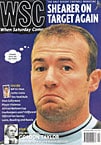 John Williams of the Sir Norman Chester Centre for Football Research examines the findings from the latest Premier League fans survey and a similar report covering Nationwide League clubs
John Williams of the Sir Norman Chester Centre for Football Research examines the findings from the latest Premier League fans survey and a similar report covering Nationwide League clubs
Embarking on the National Fan Survey is, even now after a few years of trying, still something of a dip into the unknown. Experienced clubs have a nasty habit of “forgetting” exactly what it was they had done last time to achieve a reasonable supporter sample. New recruits have to be carefully schooled in the job to be done.
For the first time Football League clubs were surveyed too, with 19 of them providing usable data. Since you ask, about eight out of ten of both Bristol Rovers and City season ticket fans are born locally, but Rovers fans think that their club is the friendly one and that their supporters have good links with the Rovers players. Rovers fans also love the old blue quartered strip – best of the Football League bunch they reckon. Also an amazing 58 per cent of Wycombe Wanderers season ticket holders currently also support another club, and lots of Exeter City season ticket fans live near the St James ground. The typical Grecian, wise person, spends just £25 in a season on club merchandise, a Football League low (£100 high at Wolves, £134 at Rangers).
The loneliest Football League crowd? One in eight (12 per cent) Barnsley regulars attends Oakwell alone. At Swansea City the locals don’t like being at the match alone; they like to be with their (male) mates. The Swans have the largest proportion of all male fan groups and the fewest female season ticket fans (eight per cent). But Celtic have fewer. Exeter City (them again) top the female charts here at 18 per cent. Bristol Rovers, wouldn’t you know it, have more female devotees than Bristol City. Swansea City fans also report more racism than found elsewhere – which may have nothing to do with gender and may be down to just one notable incident, of course.
We can also track the generational shift from support for Liverpool, the national club of the 1970s (favourite “other” club of Football League adults), to Man Utd, national club of the 1990s (favourite club of Football League fans’ kids who support elsewhere).
In the Premier League survey we were faced with complications. Chelsea’s sample this time looks very affluent – even by the standards of the Fulham Road – Derby County’s surely has too many females (22 per cent), and Man Utd’s looks much too local and low spending compared with what we collected in 1997. We also had a sharp downturn in the response rate this time – 39 per cent to 28 per cent – partly because of some clubs not really getting themselves together. All of this makes simple comparisons with the last survey in 1997 quite difficult. We like to look at season ticket prices, for example, taking into account price reductions where appropriate. The national increase in season ticket prices over two years (1997-1999) comes out at just over eight per cent – surely too low. If we look only at fans in their thirties – probably a more stable comparison – the figure comes out at closer to 19 per cent, probably more like it.
What also seems to be happening here is that the gap between the cheaper clubs and the more expensive ones is widening. Hats off to Everton, Sheffield Wednesday and Wimbledon (though they all need the fans, of course) and especially to Arsenal (who don’t) for keeping a clamp on prices. A different message to Spurs and Chelsea. Incidentally, foreign season ticket fans are registering quite strongly now at Chelsea and Wimbledon, as well as more modestly at Man United and Liverpool.
In fact, while most top clubs seem to struggle to recruit British black and Asian fans (0.9 per cent in the Premier League and a desultory 0.3 per cent at Football League clubs) the fan foreign invasion seems to be off and running at some of the multinationals.
Although the tabloids drooled, hypocritically, over the clubs with “no” ethnic minority fans – we eventually found a few, incidentally, at Blackburn – the figures are generally so small here, with a large margin for error, that a table on this really makes little sense. We might be better off wondering why a club like Leicester City – by no means a slouch in trying to “reach” minorities – still has fewer than two per cent minority fans (a leader here) in a city that actually boasts more than 30 per cent of people now from an Asian background. The so-called league tables of racist clubs, where fans report high incidence of racism at matches, may actually be a sign of increasing sensitivity to the problem at some places. Or, as at Leicester, a likely reporting of racism among visiting fans, who apparently still think it’s a problem being white and living in a town, as they erroneously describe it, which is “full of Pakis”.
A couple of final thoughts: flotations where supporters have a good chance of becoming shareholders – at Celtic and Charlton for example – also have a good chance of shifting fans’ views on the stock market and football. And, most Premier League fans think their clubs have a better chance of winning something now than they did five years ago. (Do they mean it?) Chelsea lead this table. In the basement, however, 65 per cent of Football League fans think there will be fewer than 72 Football League clubs in five years time. You work it out.
From WSC 158 April 2000. What was happening this month